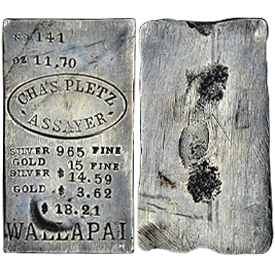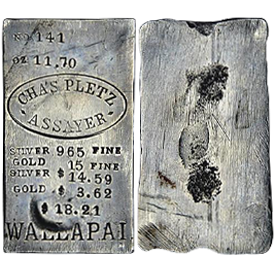Very little is recorded of Charles Pletz beyond a few bare notices in Arizona’s Weekly Miner newspaper of the mid-1870s. The paper’s issue of May 14, 1875 notes Pletz as superintendent of the Mass Mine while the following June 4 the paper notes Pletz’ interest in mining in the Mineral Park District. For July 9, 1875 the paper stated that Pletz would operate a mining mill at Mineral Park. The issue of October 22, 1875 noted that Pletz had opened an assay office, location not noted. On July 14, 1876 the paper reported that Pletz was to be named supervisor of the Quartz Mounting Mill. On November 17, 1876 the same paper noted Pletz as assistant assayer of the Aztlan Mill and on March 9 of the following year reported that Pletz had sold an interest in the Everett Mine. The last mention of Pletz is a notice in The Miner of November 9, 1932, that describes a place in the Cerbat Mountain where a certain Jack Flynn dug out several hundred pounds of silver ore, samples of which assayed out at Pletz’ assay office at more than $3,000 a ton.
There are only three known Pletz ingots. The ingot from the John J. Ford, Jr. Sale was no. 141. Ingot no. 235 was illustrated in How They Dug the Gold (Arizona Pioneer’s Historical Society, 1967). Mr. Ford contacted the bar’s owner, a Mr. Milton Singer of Bloomfield, Connecticut in August, 1973, asking, without success as it turned out, if the bar were for sale. In his letter to Singer, Mr. Ford mentioned he knew of one other Pletz ingot, bar no. 141. Nearly five years later, on February 20, 1978, Mr. Ford made a second attempt to buy Singer’s Pletz ingot, this time offering $1,000 for it. Mr. Singer again declined to sell the bar, but sent Mr. Ford photographs of it for his files. Then, on December 17, 1979 Don Kagin received a letter from Mr. Singer asking if there was a Pletz bar in the Clifford Collection. Don forwarded Singer’s letter to Mr. Ford, who replied that there wasn’t and reminded Singer once again of Ford’s interest in buying Singer’s Pletz bar. Singer graciously declined once more, but offered Mr. Ford some information that helped locate Pletz' assay office in Mohave County, Arizona. In December, 1984, Singer wrote Ford saying that his son wanted to have the Pletz bar, implying that it was thereafter “off the market”, but the bar appeared
for sale in John Hamilton’s fixed price list offering published in the TAMS Journal in February, 1991. In February, 1993 Hal Birt wrote Ford saying that Hamilton had brought the bar to the recent Tucson show. Its present whereabouts are unknown to the cataloguer and were to Mr. Ford.
A third Pletz ingot is bar no. 28, from the collection of the Sharlot Hall Historical Society in Prescott, Arizona. Paul Franklin brought the bar’s existence to Mr. Ford’s attention towards the end of 1979, a few months before Mr. Singer wrote to Don Kagin about Pletz. On September 14, 1979 Norm Tessman, Curator of Collections for the So- ciety, sent photographs of their ingot to Franklin, and Paul forwarded them on to Mr. Ford. Ford replied immediately, asking for additional photographs and other information, particularly about assayer Frank Blake. A few months later, after Ford received Singer’s letter about Pletz’ Mohave County location. Ford wrote Tessman once again, repeating his earlier request. Tessman replied almost immediately, saying he had neglected Mr. Ford’s earlier request for information in part because “Quite frankly, I had just rejected Paul Franklin’s attempt to obtain the Pletz ingot and was slightly sour about what I perceived (again perhaps unjustly) as an attempt to take advantage of the Museum.” Tessman offered to make his research library available to Mr. Ford should a visit to the Society be thought worthwhile. The ingot’s present whereabouts have not been ascertained.
The Ford and Sharlot Hall Historical Society Pletz bars are similar in size, style, and layout. Both have their inscriptions arranged across the shorter dimension of the rectangular shape. On both, the bar number is first followed by the bar's weight and the assayer’s logotype stamp (the same on both). Thereafter the two bars are somewhat dissimilar. On Ford’s, the gold and silver finenesses and value are next whereas the Sharlot Hall bar has only its silver fineness and value. Since the Sharlot Hall bar’s fineness is given as 987, one wonders why Pletz felt it was unnecessary to indicate that bar’s gold fineness of .013 when on the
Ford bar he stamped GOLD 15 FINE and on the Singer bar he noted GOLD 0.10 FINE. Another difference between the Ford and Sharlot Hall ingots is the absence of a location on the latter, which is given as WALLAPAI on Ford’s (and Singer’s) bar. Finally, both Ford’s and the Sharlot Hall’s Pletz bars have no inscriptions anywhere save on their faces.
Like the Ford bar, Singer’s also states the location name but unlike Ford’s, does so on one long edge. Singer’s bar arranged its information partly along the short dimension of the rectangular shape, but after noting the bar’s number and weight, then changes to the long dimension to list the finenesses and values. In addition, on Singer’s bar the assayer’s logotype stamp, which is the same one seen on the Ford and Sharlot Hall ingots, is placed on the back of Singer’s and is partly obscured by the cooling depression there.
All three Pletz ingots are small bars principally of silver with rather low values, $14.57 (Sharlot Hall), $11.25 (Singer), and $18.21 (Ford).







